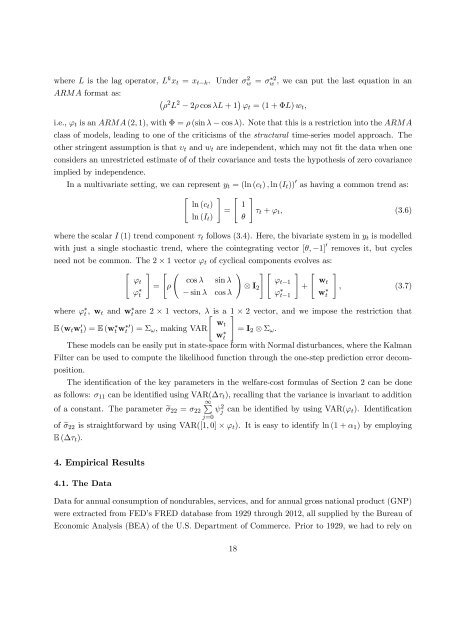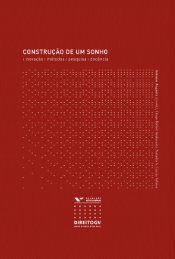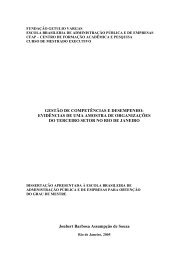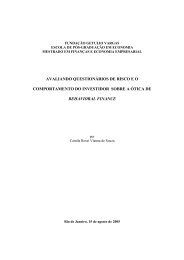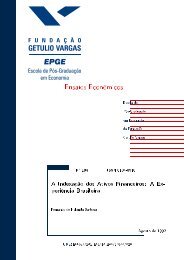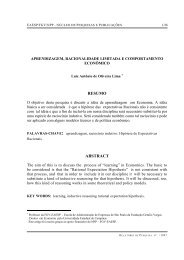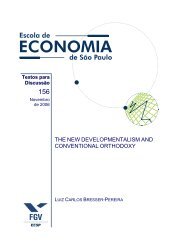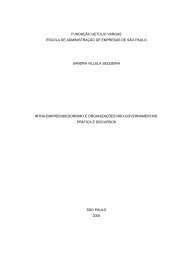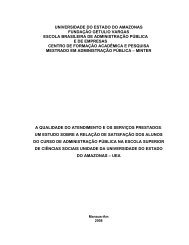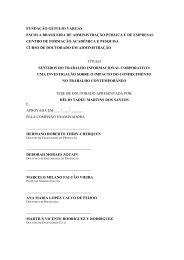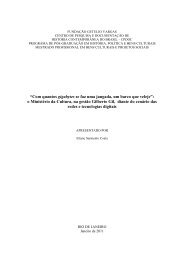Ensaios Econômicos - Sistema de Bibliotecas da FGV - Fundação ...
Ensaios Econômicos - Sistema de Bibliotecas da FGV - Fundação ...
Ensaios Econômicos - Sistema de Bibliotecas da FGV - Fundação ...
Create successful ePaper yourself
Turn your PDF publications into a flip-book with our unique Google optimized e-Paper software.
where L is the lag operator, L k x t = x t<br />
ARMA format as:<br />
i.e., ' t is an ARMA (2; 1), with = (sin <br />
k . Un<strong>de</strong>r 2 w = 2<br />
w , we can put the last equation in an<br />
2 L 2 2 cos L + 1 ' t = (1 + L) w t ;<br />
cos ). Note that this is a restriction into the ARMA<br />
class of mo<strong>de</strong>ls, leading to one of the criticisms of the structural time-series mo<strong>de</strong>l approach. The<br />
other stringent assumption is that t and w t are in<strong>de</strong>pen<strong>de</strong>nt, which may not …t the <strong>da</strong>ta when one<br />
consi<strong>de</strong>rs an unrestricted estimate of of their covariance and tests the hypothesis of zero covariance<br />
implied by in<strong>de</strong>pen<strong>de</strong>nce.<br />
In a multivariate setting, we can represent y t = (ln (c t ) ; ln (I t )) 0 as having a common trend as:<br />
" # " #<br />
ln (c t ) 1<br />
= t + ' t ; (3.6)<br />
ln (I t ) <br />
where the scalar I (1) trend component t follows (3.4). Here, the bivariate system in y t is mo<strong>de</strong>lled<br />
with just a single stochastic trend, where the cointegrating vector [;<br />
1] 0 removes it, but cycles<br />
need not be common. The 2 1 vector ' t of cyclical components evolves as:<br />
" # "<br />
! # " # " #<br />
' t<br />
cos sin <br />
' t 1 w t<br />
= <br />
I 2 + ; (3.7)<br />
sin cos <br />
' t<br />
where ' t , w t and wt are 2 1 vectors, "<br />
is a 1#<br />
2 vector, and we impose the restriction that<br />
E (w t w 0 t) = E (w t w 0<br />
t ) = ! , making VAR<br />
w t<br />
w t<br />
= I 2 ! .<br />
These mo<strong>de</strong>ls can be easily put in state-space form with Normal disturbances, where the Kalman<br />
Filter can be used to compute the likelihood function through the one-step prediction error <strong>de</strong>composition.<br />
The i<strong>de</strong>nti…cation of the key parameters in the welfare-cost formulas of Section 2 can be done<br />
as follows: 11 can be i<strong>de</strong>nti…ed using VAR( t ), recalling that the variance is invariant to addition<br />
1P<br />
of a constant. The parameter e 22 = <br />
2 22 j can be i<strong>de</strong>nti…ed by using VAR(' t). I<strong>de</strong>nti…cation<br />
j=0<br />
of e 22 is straightforward by using VAR([1; 0] ' t ). It is easy to i<strong>de</strong>ntify ln (1 + 1 ) by employing<br />
E ( t ).<br />
' t 1<br />
w t<br />
4. Empirical Results<br />
4.1. The Data<br />
Data for annual consumption of nondurables, services, and for annual gross national product (GNP)<br />
were extracted from FED’s FRED <strong>da</strong>tabase from 1929 through 2012, all supplied by the Bureau of<br />
Economic Analysis (BEA) of the U.S. Department of Commerce. Prior to 1929, we had to rely on<br />
18


